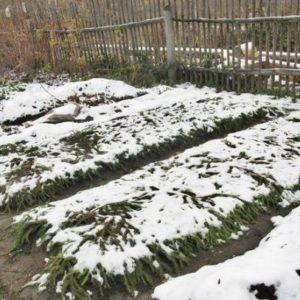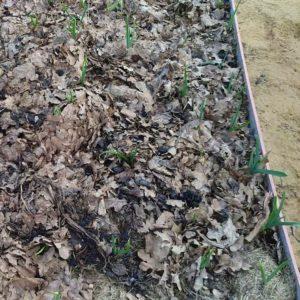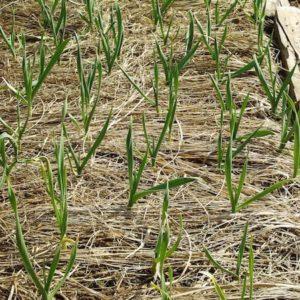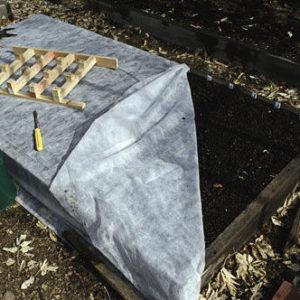Saving the harvest from the cold: how to cover garlic for the winter, how and when to do it correctly
Garlic is a plant well known to any gardener. About its benefits and taste already a lot has been said.
It is important to remember that when planting this crop in winter, be sure to cover the soil. This affects both the quality and quantity of the harvest. How and with what to cover garlic in the cold - read our article.
Why do you need to cover the beds?
Many gardeners are familiar with the technique of planting garlic “in winter”, because this method has significant advantages:
- planting material undergoes excellent hardening, which means it is resistant to diseases;
- winter garlic produces vigorous shoots;
- plants are not afraid of drought at the growth stage;
- this garlic is great stored;
- saves the gardener valuable time in the spring.
Garlic planted in winter must be covered. This is done primarily to protect young plants from frost. Without shelter, the number of surviving plants is significantly reduced and they are much weaker.
Other benefits of covering garlic:
- plants survive temperature changes, because winter thaws can encourage garlic to grow;
- the future garlic harvest increases;
- sprouts are protected from certain diseases and pests;
- prevents excessive soil moisture when snow melts, and therefore rotting;
- harvest 1-2 weeks earlier;
- The gardener’s valuable time is saved in the spring, since the shoots will be friendly and strong.
How to plant garlic? Read Here.
How to cover a garden bed
 Immediately after planting the cloves, the bed is sprinkled with a mixture of sand and ash, which ensures drainage. Winter crops must be closed before the onset of negative temperatures. Each climate zone has its own timing. (in the middle zone this is mid-November).
Immediately after planting the cloves, the bed is sprinkled with a mixture of sand and ash, which ensures drainage. Winter crops must be closed before the onset of negative temperatures. Each climate zone has its own timing. (in the middle zone this is mid-November).
The thickness of the covering layer ranges from 3-4 cm to 5-7 cm, depending on the density of the selected material.
Of course, you need to monitor the weather forecast so as not to miss time. In the spring, when it becomes warm, the shelter from the young shoots is removed.
Top 36 best varieties of garlic, details in this article.
How to cover garlic for the winter
There are many options for covering your plantings:
- organic materials (peat, plant stems, sawdust, fallen leaves, straw, spruce branches);
- agrofibre (aka spunbond).
Each of them has its own pros and cons.
Organic materials
Peat To cover the beds, use dry and crushed ones; it is highly undesirable to cover them with fresh ones. The cover layer is 5-7 cm. Peat retains heat well, which allows you to protect plants even from severe frosts. It is good for mulching and retains moisture. Of the minuses: It oxidizes the soil and, when very wet, becomes compacted and forms a crust.
 Fallen leaves - another excellent organic covering material. In any garden in the fall you can easily find the required amount of fallen leaves. It is not recommended to use oak leaves – the tannins included in the composition will inhibit the development of young plants.
Fallen leaves - another excellent organic covering material. In any garden in the fall you can easily find the required amount of fallen leaves. It is not recommended to use oak leaves – the tannins included in the composition will inhibit the development of young plants.
This type of shelter conducts air well and retains heat at the same time. But remember that the leaves can freeze or, conversely, rot if there is a sudden change in temperature.
The disadvantage of this option is that the leaves may contain various fungi that they inherited from the tree, as well as many insects that like to overwinter in the foliage. This, of course, will not add strength and health to the young shoots.
Plant stems - also a good material at hand for winter planting. Use only stems, no inflorescences and seeds. This type of shelter holds snow well and prevents the soil from becoming waterlogged.
Disadvantage of this method: The stems gradually overheat and become denser, so a crust forms. Also, the stems can be infected with various fungi and are susceptible to mold, which also risks harming young shoots of garlic.
 Straw - also one of the shelter options. Chopped, partially rotted straw is used. Fresh ones can easily be blown away from the garden by the wind, and bacteria draw nitrogen from the soil during decomposition.
Straw - also one of the shelter options. Chopped, partially rotted straw is used. Fresh ones can easily be blown away from the garden by the wind, and bacteria draw nitrogen from the soil during decomposition.
An excellent covering material is considered to be mowed and dried grass from the rows of the garden without weed seeds. In this case, the bed is covered with a layer of 8-10 cm.
Sawdust also used to cover garlic beds. It is ideal if sawdust mixed with coniferous tree needles is used, as this will repel rodents. Such a shelter will provide good thermal insulation and retain excess moisture.
When using sawdust, remember that it oxidizes the soil, and when wet, it forms a rather dense layer that prevents air penetration.
If there is a coniferous forest near your site, use spruce branches as cover. It retains heat and provides air access to young plants. Lapnik also repels rodents. But it is necessary to take into account that fallen needles will acidify the soil. If you decide to use spruce branches, carefully select the tree to collect branches from. Red spots and reddish needles on the tree indicate its illness.
Spunbond
Agrofibre – a new, but already well-proven synthetic material. This is a thin film of polypropylene. The material allows light to pass through and will prevent winter garlic from freezing.
Attention! The heat-insulating properties of agrofibre are not sufficient for central Russia. Therefore, in regions with severe winters, it is necessary to add another covering layer on top of the spunbond.
 Using the material is simple: It is enough just to cover the garden bed with it and press the edges with pebbles or sprinkle with earth. Spunbond can be used more than once, but for 4-5 seasons.
Using the material is simple: It is enough just to cover the garden bed with it and press the edges with pebbles or sprinkle with earth. Spunbond can be used more than once, but for 4-5 seasons.
In spring, they cover crops of other crops. Cover garlic plantings with agrofibre at the usual time, that is, before frost.
Disadvantage of material - only that you need to buy it.
Tips and tricks
There are many options for covering winter garlic. Each of them has its own advantages and disadvantages. We recommend taking a holistic approach to shelter. After planting, mulch the bed with a mixture of sand and ash.
Then, when it's time to cover:
- pour peat 3-4 cm high onto the bed;
- lay the spunbond;
- cover it with any available organic material (leaves, straw, plant stems);
- Cover the very top of the beds with snow in the near future.
This option will reliably protect the cloves from freezing, pests and getting wet. In the spring, remove the shelter, and you will see how actively and harmoniously the shoots begin to grow.
conclusions
There are many benefits to growing garlic securely covered in winter. The main argument is a friendly and stable harvest of winter garlic next summer.When choosing a method, consider the factors of your garden, the climate of the region and your capabilities. Remember the effectiveness of enriching the soil using organic methods and use modern materials.